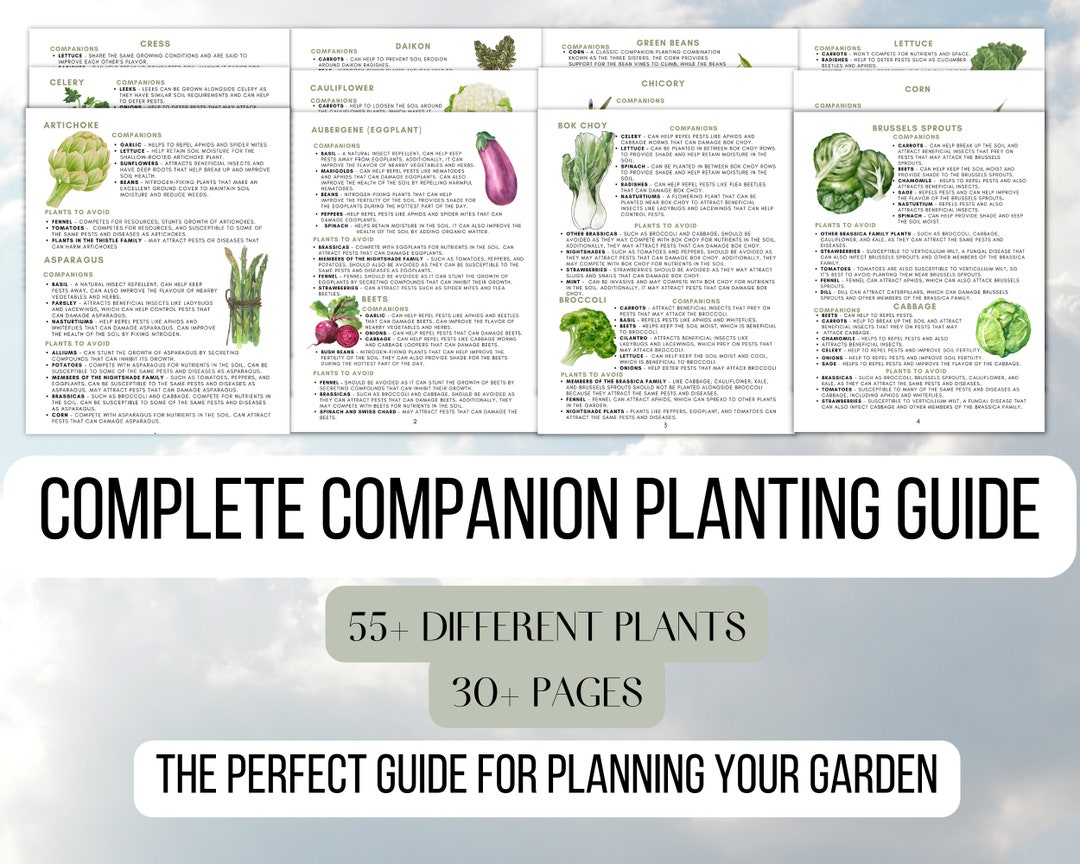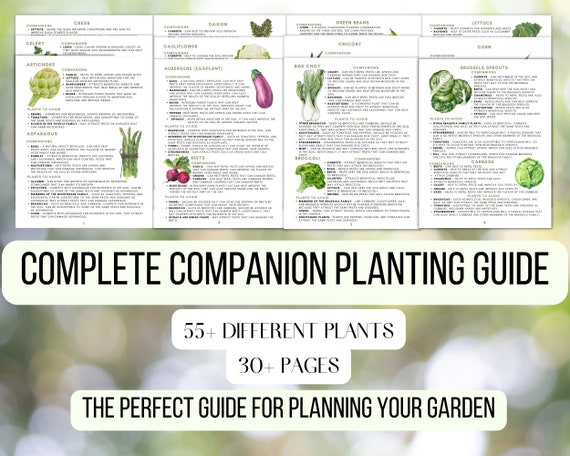The Ultimate Bok Choy Companion Planting Chart
The Ultimate Bok Choy Companion Planting Chart
Bok choy is a delicious and versatile vegetable that can be enjoyed in a variety of dishes. It is also a relatively easy crop to grow, but there are a few things you can do to help ensure a successful harvest. One of the most important things is to plant bok choy with the right companion plants.
Companion planting is the practice of planting certain crops together in order to benefit each other. Some companion plants can help to deter pests, improve soil quality, or even enhance the flavor of your bok choy.
In this blog post, we will discuss the best companion plants for bok choy. We will also provide a companion planting chart that you can use to plan your bok choy garden.
Why Companion Planting Matters
There are many reasons why companion planting is important. Here are a few of the most important benefits:
- Pest control: Certain companion plants can help to deter pests that are attracted to bok choy. For example, marigolds and nasturtiums are known to repel aphids, cabbageworms, and other pests.
- Improved soil quality: Some companion plants can help to improve the soil quality in your garden. For example, legumes, such as beans and peas, can fix nitrogen in the soil, which can benefit other plants.
- Enhancement of flavor: Some companion plants can actually enhance the flavor of your bok choy. For example, chamomile and dill can add a subtle sweetness to the leaves.
The Best Companion Plants for Bok Choy
Here are some of the best companion plants for bok choy:
- Allium family: Alliums, such as garlic, onions, and chives, can help to repel pests that are attracted to bok choy.
- Beneficial insects: Some companion plants attract beneficial insects, such as ladybugs and lacewings, which can help to control pests. For example, marigolds and nasturtiums are both known to attract beneficial insects.
- Legumes: Legumes, such as beans and peas, can fix nitrogen in the soil, which can benefit other plants. This can help to improve the growth and health of your bok choy.
- Mustard family: Plants in the mustard family, such as arugula and kale, can help to repel pests and improve the flavor of your bok choy.
- Spinach: Spinach is a good companion plant for bok choy because it has similar growing requirements. Both plants need full sun and well-drained soil.
Companion Planting Chart
The following chart provides a comprehensive list of companion plants for bok choy. The chart shows which plants are beneficial to bok choy, which plants are neutral, and which plants should be avoided.
| Companion Plant | Beneficial | Neutral | Avoid |
|---|---|---|---|
| Allium family | Yes | ||
| Beans | Yes | ||
| Beneficial insects | Yes | ||
| Cabbage family | No | ||
| Carrots | Yes | ||
| Chamomile | Yes |
Conclusion
Companion planting is a great way to improve the growth, health, and flavor of your bok choy. By planting bok choy with the right companion plants, you can help to deter pests, improve soil quality, and even enhance the flavor of your bok choy.
The companion planting chart provided in this blog post can help you to plan your bok choy garden. By following the recommendations in the chart, you can be sure that your bok choy will thrive.
Bok choy is a delicious and versatile vegetable that can be enjoyed in many dishes. But did you know that companion planting can help your bok choy plants grow healthier and produce more bountiful harvests?
Companion planting is the practice of planting certain types of plants together in order to benefit each other. Some plants, for example, can help to repel pests or attract beneficial insects. Others can help to improve the soil quality or provide shade.
There are a number of great companion plants for bok choy. Some of the best include:
- Beetroot: Beetroot helps to improve the soil quality and can also help to repel pests.
- Bush beans: Bush beans fix nitrogen in the soil, which can benefit bok choy plants.
- Carrots: Carrots and bok choy have similar growth requirements and can be planted together without competing for resources.
- Celery: Celery can help to repel pests and attract beneficial insects.
- Cucumber: Cucumbers and bok choy can be planted together to help shade the bok choy plants from the hot sun.
If you're interested in learning more about bok choy companion planting, I recommend visiting Gardenia Inspiration. This website has a comprehensive companion planting chart that lists all of the best companion plants for bok choy. You can also find information on how to plant and care for bok choy plants, as well as recipes for using bok choy in your cooking.
FAQ of bok choy companion planting chart
Q: What are some good companion plants for bok choy?
A: Bok choy is a cool-season vegetable that is generally pest- and disease-resistant. It can be grown in full sun or partial shade, and it prefers moist, well-drained soil. Some good companion plants for bok choy include:
- Cucumbers: Cucumbers help to repel aphids, which can be a problem for bok choy.
- Dill: Dill attracts beneficial insects, such as ladybugs and hoverflies, which help to control pests.
- Garlic: Garlic helps to repel nematodes, which can be a problem for bok choy.
- Kale: Kale and bok choy are both members of the Brassica family, and they can help to improve the flavor of each other.
- Onions: Onions help to repel carrot flies, which can be a problem for bok choy.
Q: What are some bad companion plants for bok choy?
A: Some bad companion plants for bok choy include:
- Broccoli: Broccoli and bok choy are both members of the Brassica family, and they can cross-pollinate, which can lead to weaker plants.
- Carrots: Carrots are susceptible to carrot flies, which can also be a problem for bok choy.
- Peas: Peas can attract pests, such as aphids and pea moths, which can also be a problem for bok choy.
- Spinach: Spinach can shade out bok choy, and it can also attract pests, such as slugs and snails.
- Tomatoes: Tomatoes can attract pests, such as hornworms and whiteflies, which can also be a problem for bok choy.
Q: How much space do bok choy plants need?
A: Bok choy plants need at least 18 inches of space between them. This is because they have a large root system that needs room to spread out. If bok choy plants are planted too close together, they will not be able to grow properly.
Q: What are some tips for companion planting bok choy?
A: Here are some tips for companion planting bok choy:
- Plant bok choy with other cool-season vegetables, such as lettuce, spinach, and kale.
- Avoid planting bok choy with other members of the Brassica family, such as broccoli, cauliflower, and Brussels sprouts.
- Plant bok choy with herbs, such as dill, garlic, and oregano.
- Plant bok choy in full sun or partial shade.
- Water bok choy regularly, especially during hot weather.
- Fertilize bok choy every few weeks with a balanced fertilizer.
Q: What are some common pests and diseases that affect bok choy?
A: Some common pests and diseases that affect bok choy include:
- Aphids: Aphids are small, sap-sucking insects that can damage bok choy plants. They can be controlled with insecticidal soap or neem oil.
- Carrot flies: Carrot flies are small, black flies that lay their eggs in carrot and other root vegetables. The larvae of the carrot fly can damage bok choy plants. They can be controlled with insecticidal soap or neem oil.
- Leaf miners: Leaf miners are small insects that tunnel through the leaves of bok choy plants. They can cause unsightly damage to the leaves, but they do not usually kill the plants. They can be controlled by removing and destroying infected leaves.
- Slugs and snails: Slugs and snails are mollusks that can feed on the leaves and stems of bok choy plants. They can be controlled with slug bait or beer traps.
Image of bok choy companion planting chart
- Image 1: This image shows a simple companion planting chart with bok choy at the center. The chart lists other vegetables that are good to plant near bok choy, such as carrots, beans, and lettuce. It also lists vegetables that should not be planted near bok choy, such as tomatoes and potatoes.

- Image 2: This image is a more detailed companion planting chart that shows the relationships between different types of plants. The chart shows that bok choy is a good companion plant for many vegetables, including carrots, beans, lettuce, onions, and spinach. It also shows that bok choy should not be planted near tomatoes, potatoes, or strawberries.

- Image 3: This image is a circular companion planting chart with bok choy at the center. The chart shows the different zones of the garden and which vegetables are good to plant in each zone. Bok choy is a good plant for the middle zone of the garden, which is a shady area.

- Image 4: This image is a 3D companion planting chart with bok choy at the top. The chart shows the different heights of different plants and how they can be planted together to create a more efficient garden. Bok choy is a short plant that can be planted with taller plants, such as tomatoes and corn.

- Image 5: This image is a colorful companion planting chart with bok choy at the center. The chart uses different colors to show the different relationships between different types of plants. Bok choy is shown in green, which indicates that it is a good companion plant for many other vegetables.

Post a Comment for "The Ultimate Bok Choy Companion Planting Chart"